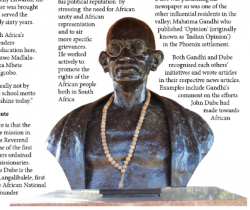WOZA eNANDA2014-09-02 WOZA eNANDA, Come to Inanda, and join in the celebration of the lives of some of the legendary people who have helped shape the history of liberation in South Africa as well as have left a lasting legacy on the world.
The Inanda Valley Heritage Route serves as an inspiration to the people that visit as well as pays tribute to those who have made their mark on this area including Mahatma Gandhi, Pixley ka Seme, John Langalibalele Dube, Isaai Shembe and Nelson Mandela. Inanda Seminary The Inanda Seminary is one of the best known and oldest schools for African girls in South Africa. Daniel and Lucy Lindley were sent by the American Board of Missions to South Africa in in 1835, as one of six couples sent to start mission work in the country. They decided to found a school for nineteen young girls who would board at Inanda. Funds for the school were provided by the American Missionary Board, Mary Kelly Edwards, the first head teacher was brought from Ohio and served the school for nearly sixty years. Many of South Africa’s black women leaders received their education here, including Nozizwe Madlala-Rutledge, Baleka Mbete and Lauretta Ngcobo. It is perhaps really not by chance that the school motto is "Inanda will shine today." Ohlange Institute Of significance is that the Lindleys left the mission in the hands of the Reverend James Dube, one of the first African ministers ordained by American missionaries. Reverend James Dube is the father of John Langalibalele, first president of the African National Congress and founder of Ohlange High School. Nicknamed Mafukuzela, John Dube was born on the 11 February 1871 and died on 11 February 1946. Dr. John L. Dube is highly regarded as an educationist, journalist, and as a political leader. His education included the Oberlin College, Ohio (1888-1890) and later at the Union Missionary Training Institute in Brooklyn. These years were to shape much of his future life, including his Christian beliefs and values. In 1901 Dube founded the Zulu Christian Industrial School, later renamed the Ohlange Institute. Whereas initially the school focused on teaching industrial skills, it later included humanities and science. Ohlange pushed the boundaries of apartheid South Africa in an attempt to better the lives of its pupils. One of the most prominent writers of his time, Dube was founder of the Zulu/English newspaper Ilanga lase Natal (Sun of Natal) in 1903, which is still published today. It was through this paper that he established his political reputation by stressing the need for African unity and African representation and to air more specific grievances. He worked actively to promote the rights of the African people both in South Africa and abroad by raising funds, writing and giving talks. Dube is also the writer of the first Zulu book- The Black Man Is His Own Worst Enemy (1922), in which he preached the gospel of self-help and inner change. In honour of the pioneering work done by Dube, Nelson Mandela decided in 1994 to cast his vote Ohlange High School when South Africa had its first truly democratic elections. After his vote he went to the graveside of John Dube and said, “I am here before you Mr. President to report to you that South Africa is free and now may your soul rest in peace.†Exciting projects are now underway to expand the development that has already taken place at Ohlange. John Dube’s original house has already been restored as a museum with his statue (a bronze sculpture by Andries Botha) seated on the veranda. The former chapel is now the African Renaissance Centre and houses a tribute to Nelson Mandela voting site which includes his statue (also sculptured by Andries Botha) and other historical displays. An amphitheatre is currently under construction along with a new access road and improved parking facilities. Future plans include the re-establishment of the school, which will provide teaching in line with the principles of John Dube and the creation of a bed and breakfast accommodation in the boy’s hostel. Mahatma Gandhi and John Dube At the same time that John Dube was publishing his newspaper so was one of the other influential residents in the valley, Mahatma Gandhi who published ‘Opinion’ (originally known as ‘Indian Opinion’) in the Phoenix settlement. Both Gandhi and Dube recognised each others’ hard work and wrote articles in their respective news articles. Examples include Gandhi’s comment on the efforts John Dube had made towards African education, holding him out as “an inspiration for all coloured peopleâ€. Similarly when Gandhi was imprisoned in Johannesburg in January 1908, Dube’s paper commented on “the courageous manner in which the Indians are acting in the Transvaalâ€. Phoenix Settlement The house named Sarvodaya (Well Being for All) was originally build for Gandhi and his family in 1904. The current building is a reconstruction of the original house, which was burnt down during the 1985 Inanda Riots and now dedicated as a monument to peace and justice. A slow walk in silence through Mahatma Gandhi‘s house to read some accounts of his life as well as insights into his personal thoughts is an exercise in humility. Located in the Phoenix settlement is the building housing the International Printing Press building which published ‘Opinion’. This newspaper came into existence in 1903 and continued publication until 1961. The building is now the tourism office for the Phoenix settlement. The settlement also houses an exhibition pertaining to the history of the area. Other places of interest in the Inanda Valley include the Shembe settlement of Ebuhleni, Mzinyathi Falls, and Inanda Dam. Visit www.durbanexpereince.co.za for more information |
WOZA eNANDA
Copyright © 2024 KwaZulu-Natal Top Business
